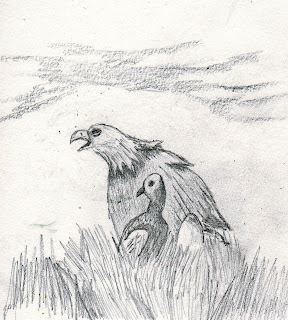Title:
The Eagle’s Eggs
Eagle of sky high (5)
with eggs resting quietly, (7)
feathers the wind wakes. (5)
By the Hawk
This is an attempt at a haiku poem that describes
nature and the cycle of life. It creates a patriotic image of the most noble
creature of the sky existing as protector of freedom. The old are the nest
makers of the young and each successful egg represents another opportunity to finish
the fulfillment of a societal promise. The cycle will continue until the eggs
are no longer protected against the elements of nature or they fail to become
eagles themselves (egg, chick, eagle).
Even though the poem is a first attempt, it is
helpful to think about what this means in terms of our lives. As Americans, we
are part of a cycle and each child offers an opportunity to fulfill a destiny
and promise. That promise is rooted in human and societal development as a
nation. Each generation is another opportunity. It should help people think beyond themselves to the
essence of life and the choices they make because these choices influence a running chain of events.
Haiku is a short poem that uses language to express
a feeling or express an image. They are considered more than simple poems
because they can be seen as a way of looking at the world and finding something
deeper; like the essence of existence.
As a short poem, they are abrupt in their expression of the event
leaving the reader thinking of meaning.
The haiku poems started in the 9th and 12th
century Japan as a type of game. A person would write the first section and
another person would write the second section. Today’s poems might only have
the first section of the poem structure.
The general poem uses a 5-7-5 syllables structure. To determine this you can simple clap them out on your hands much like you did in grade school English class. The poem is most often written in present form and focuses on the association of images. It is the connection of these images that create the total experience.
Because my poem is amateur by nature, I don’t believe it is fair to leave you with this as appropriate. Therefore, I have provided you with a stronger example from the famous haiku poet Soseki:
The general poem uses a 5-7-5 syllables structure. To determine this you can simple clap them out on your hands much like you did in grade school English class. The poem is most often written in present form and focuses on the association of images. It is the connection of these images that create the total experience.
Because my poem is amateur by nature, I don’t believe it is fair to leave you with this as appropriate. Therefore, I have provided you with a stronger example from the famous haiku poet Soseki:
Over the wintry (5)
forest, winds howl in rage (7)
with no leaves to blow. (5)
You are welcome to learn more about Soseki as a Japanese writer http://www.eldritchpress.org/ns/soseki.html
You are welcome to learn more about Soseki as a Japanese writer http://www.eldritchpress.org/ns/soseki.html
